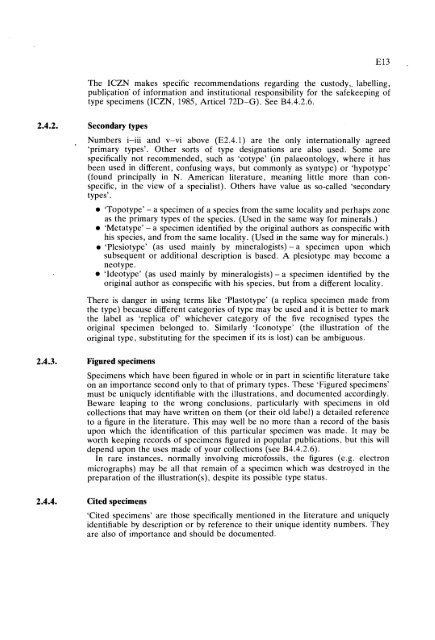GUIDELINES FOR THE CURATION OF GEOLOGICAL MATERIALS
GUIDELINES FOR THE CURATION OF GEOLOGICAL MATERIALS
GUIDELINES FOR THE CURATION OF GEOLOGICAL MATERIALS
You also want an ePaper? Increase the reach of your titles
YUMPU automatically turns print PDFs into web optimized ePapers that Google loves.
The ICZN makes specific recommendations regarding the custody,. labelling,<br />
publication' of information and institutional responsibility for the safekeeping of<br />
type specimens (ICZN, 1985, Articel 72D-G). See B4.4.2.6.<br />
Secondary types<br />
Numbers i-iii and v-vi above (E2.4.1) are the only internationally agreed<br />
'primary types'. Other sorts of type designations are also used. Some are<br />
specifically not recommended, such as 'cotype' (in palaeontology, where it has<br />
been used in different, confusing ways, but commonly as syntype) or 'hypotype'<br />
(found principally in N. American literature, meaning little more than conspecific,<br />
in the view of a specialist). Others have value as so-called 'secondary<br />
types'.<br />
'Topotype' - a specimen of a species from the same locality and zone<br />
as the primary types of the species. (Used in the same way for minerals.)<br />
'Metatype' - a specimen identified by the original authors as conspecific with<br />
his species, and from the same locality. (Used in the same way for minerals.)<br />
'Plesiotype' (as used mainly by mineralogists) -a specimen upon which<br />
subsequent or additional description is based. A plesiotype may become a<br />
neotype.<br />
'Ideotype' (as used mainly by mineralogists) - a specimen identified by the<br />
original author as conspecific with his species, but from a different locality.<br />
There is danger in using terms like 'Plastotype' (a replica specimen made from<br />
the type) because different categories of type may be used and it is better to mark<br />
the label as 'replica of' whichever category of the five recognised types the<br />
original specimen belonged to. Similarly 'Iconotype' (the illustration of the<br />
original type, substituting for the specimen if its is lost) can be ambiguous.<br />
Figured specimens<br />
Specimens which have been figured in whole or in part in scientific literature take<br />
on an importance second only to that of primary types. These 'Figured specimens'<br />
must be uniquely identifiable with the illustrations, and documented accordingly.<br />
Beware leaping to the wrong conclusions, particularly with specimens in old<br />
collections that may have written on them (or their old label) a detailed reference<br />
to a figure in the literature. This may well be no more than a record of the basis<br />
upon which the identification of this particular specimen was made. It may be<br />
worth keeping records of specimens figured in popular publications, but this will<br />
depend upon the uses made of your collections (see B4.4.2.6).<br />
In rare instances. normally involving microfossils, the figures (e.g. electron<br />
micrographs) may be all that remain of a specimen which was destroyed in the<br />
preparation of the illustration(s), despite its possible type status.<br />
Cited specimens<br />
'Cited specimens' are those specifically mentioned in the literature and uniquely<br />
identifiable by description or by reference to their unique identity numbers. They<br />
are also of importance and should be documented.

















